“We are all immigrants in one way or another. We all share the immigrant experience.”
Giancarlo Biagi

Mother Cabrini Memorial
About Mother Cabrini
Maria Francesca Cabrini, known as Mother Frances Xavier Cabrini, was an Italian-American who founded many organizations to help the needy. She was born in the small town of Sant’Angelo Lodigiano in Lombardi, Italy, in 1850, the youngest of 13 children. Before migrating to the United States, she took vows and founded the Missionary Sisters of the Sacred Heart, an order that served and schooled orphans.
Mother Cabrini arrived to the United States in 1889 on a mission to help Italian immigrants. While in New York, she taught at St. Joachim’s parish, the Church of Our Lady of Pompeii, and the Transfiguration Catholic Church – all in Manhattan – as well as St. Rita of Cascia in The Bronx and the Church of St. Stephen in Brooklyn. She also founded the Columbus Hospital, which was eventually named the Cabrini Medical Center in Manhattan. During her lifetime, she founded 67 orphanages, schools and hospitals in New York and around the world.
Mother Cabrini was originally buried in West Park and is now interred at the St. Frances Cabrini Shrine in Manhattan, which she founded. In 1946, nearly 30 years after her death, Mother Cabrini became the first naturalized U.S. citizen to be canonized. She is recognized as the patron saint of immigrants. Several academic institutions, religious buildings and hospitals across New York are named after her.
Creation of the Mother Cabrini Memorial
In October 2019, Governor Andrew Cuomo announced the appointment of the Mother Cabrini Memorial Commission to oversee the creation of a statue honoring Mother Cabrini. The Commission received submissions from artists from around the world, each movingly telling the story of her life and her many contributions to immigrants in New York and worldwide.
From these submissions the Commission selected the artist team of Jill and Giancarlo Biagi to create the Mother Cabrini Memorial. The creative team included architectural and site design work by Martin Sendlewski and lighting design by Ken Farley.
The Mother Cabrini Memorial was dedicated on October 12, 2020 and is located in Battery Park City just south of South Cove, along the Battery Park City Esplanade. With a direct view of both the Statue of Liberty and Ellis Island, this area provides a fitting location to pay tribute to the patroness of immigrants. The Memorial site is an open plaza which allows for full interaction with the statue and interpretive panels which highlight key moments in Mother Cabrini’s life. The plaza is surrounded by seating and a mosaic created with stones from Mother Cabrini’s birthplace of Sant’Angelo Lodigiano, Italy.
Read more:
– Governor Cuomo Unveils Mother Cabrini Memorial in Battery Park City
Mother Cabrini Memorial Commission Members
Frank Bisignano
Hon. RoAnn M. Destito
Bishop Nicholas DiMarzio
Bishop Orlando Findlayter
Philip Foglia, (In Memoriam)
Mario Gabelli
John Leo Heyer II
Maureen Sherry Klinsky
Gary LaBarbera
Joe Plumeri
Erminia Rivera
Joseph Sciame
Carlo Scissura
Linda Stasi
Mary Ann Tighe
Veronica Tsang
George Tsunis
John M. Viola
Angelo Vivolo
About the Memorial
The cloak represents a sail against the adverse winds that Mother Cabrini faced throughout her life. The three figures are all facing the Statue of Liberty, a beacon of hope for immigrants as they entered New York Harbor to begin their new lives in America. The young girl, a reflection of Mother Cabrini’s youth, is holding a book, a symbol of Mother Cabrini’s commitment to educating children. As music has been important to the heritage of immigrants, the young boy is holding luggage and an ocarina, an instrument invented near Francesca’s birthplace, representing the music and culture immigrants have brought to America.
The Paper Boat
As a young girl, Mother Cabrini made paper boats, filled them with violets, and set them off in a stream as her “missionaries.” The paper boat is a symbolic representation of Mother Cabrini’s journey to America, her steadfastness in the face of adversity, and her unflinching commitment to helping her fellow immigrants. Although fragile and delicate, it can hold against the water’s currents and stay afloat— symbolizing how she always maintained a perfect balance with resolution and the trust of never being defeated in her beliefs of faith, charity, and strength.
The Story of Mother Cabrini
To follow along with an audio tour:
North Panel
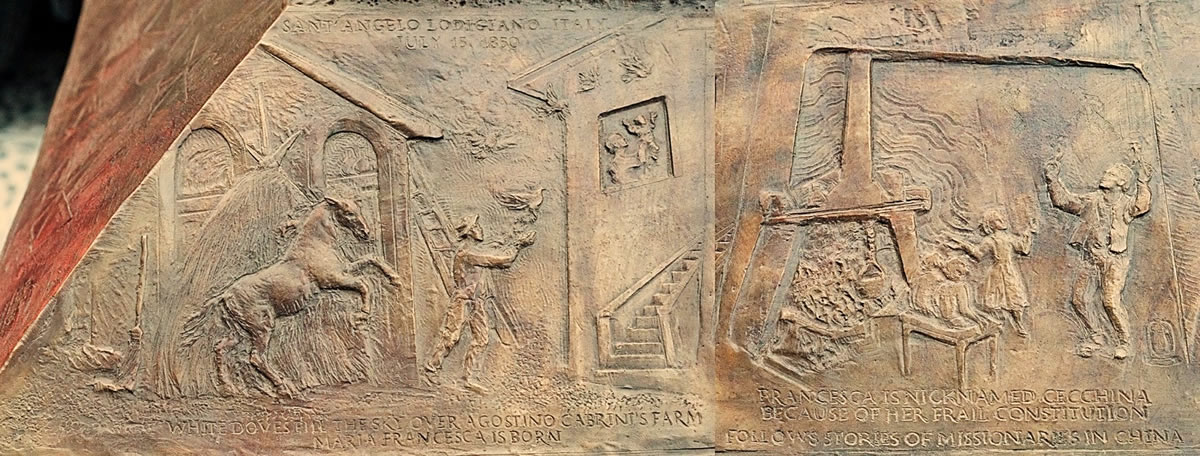
On July 15, 1850 in the small town of Sant’Angelo Lodigiano in Northern Italy, Frances Cabrini is born as a flock of doves hovers over her family’s farmhouse. As Maria-Francesca is born, a dove welcomes her into the world.
The Cabrini family gathers in the evenings listening to the stories their father, Agostino Cabrini, who tells tales of missionaries such as Francis Xavier and their heroic deeds. Frances, endearingly nicknamed Cecchina because of her minute stature, develops a lively and creative mind and becomes passionate about missionary work.
Frances wishes to follow in the footsteps of the great Jesuit Missionary Saint Francis Xavier whose deeds of plurality, care for numerous ethnic groups, tolerance for diversity and contemporary insight into spiritual globalization influences Cabrini’s direction.

Cecchina often visits her uncle Don Luigi Oldini, parish priest of Livraga who lives near the Venera River. During one of her visits, Cecchina builds a boat with wax paper from her lunch and fills it with violets, her “missionaries”. Then sends them off to China on the Venera River to rescue infant girls. She loses her balance and falls into the river and a hand rescues her, which she always believes to have been her guardian angel. Cecchina catches bronchitis after falling into the water and her sister Rosa takes good care of her, putting her back on her path to becoming the cheered advocate of immigrants and the needy around the world.
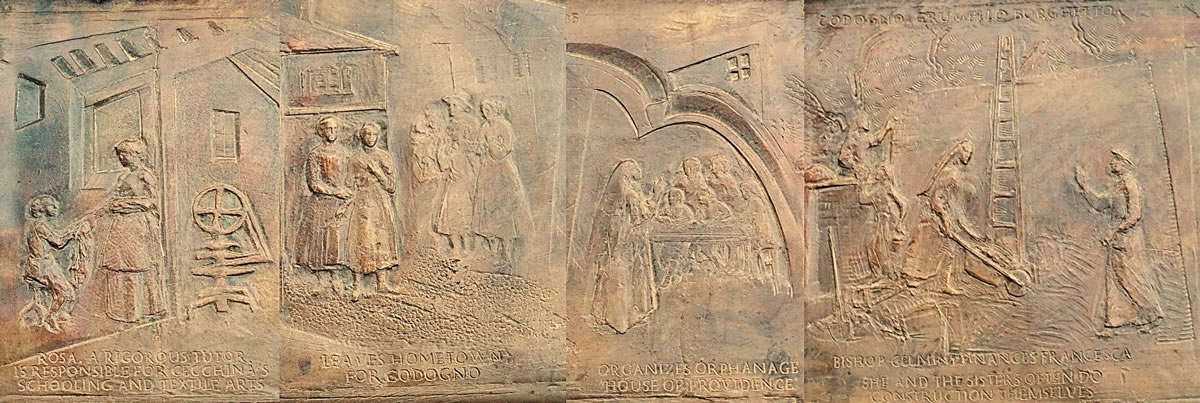
Her mother and sister Rosa are her guides in learning the art of sewing and the love of her neighbors. Rosa, now a school teacher, takes on the responsibility of Frances’s education. Although Frances has a very sweet and timid character and weak constitution, she is very lively, has a naturally strong self-identity and is full of projects. Rosa’s extremely firm disciplinary methods will be beneficial to Frances when facing the demanding tasks ahead.
In 1880, Frances leaves her hometown for Codogno, where she is assigned to teach in a charitable institution for orphans. In1882, Frances opens Grumello a mission branch that she and other sisters of her order build by hand.
After six years, the Bishop of Lodi, Archbishop Gelmini, invites Frances to found a missionary Institute. She starts the new Religious Congregation in 1880 in an old Franciscan Convent that had been closed since the time of Napoleon.

In 1887 Bishop Scalabrini, who is deeply concerned about the plight of the Italian immigrants in America created by their mass migration in search of a better life, recognizes Mother Cabrini’s administrative, organizational and financial skills as well as her passion for helping the needy and, introduces her to Pope Leo XIII who sends her on a mission: “go not to the East but to the West”.
Together with six sisters and 1,500 mostly Italian immigrants, Frances departs aboard the steamboat Bourgogne from Le Havre, France on March 23, 1889 heading for New York.
South Panel
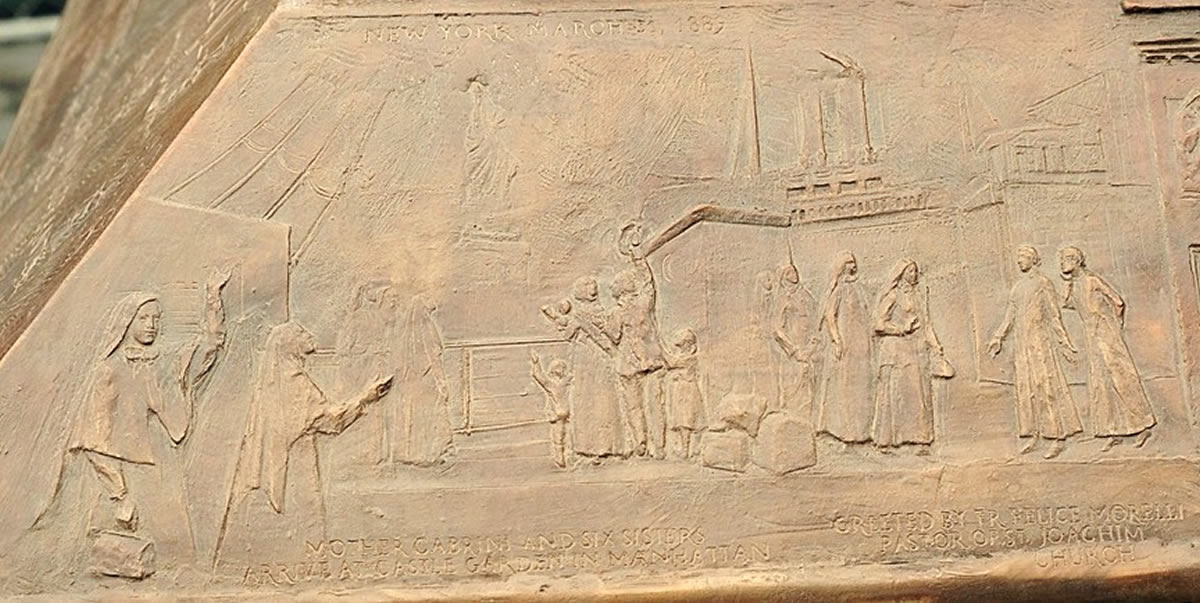
On March 31, 1889 Mother Cabrini arrives in New York with the six sisters. They are exhausted but filled with enthusiasm. Greeted by two priests, Mother Cabrini and the Sisters’ exuberance is dampened when they learn that no accommodations have been prepared.
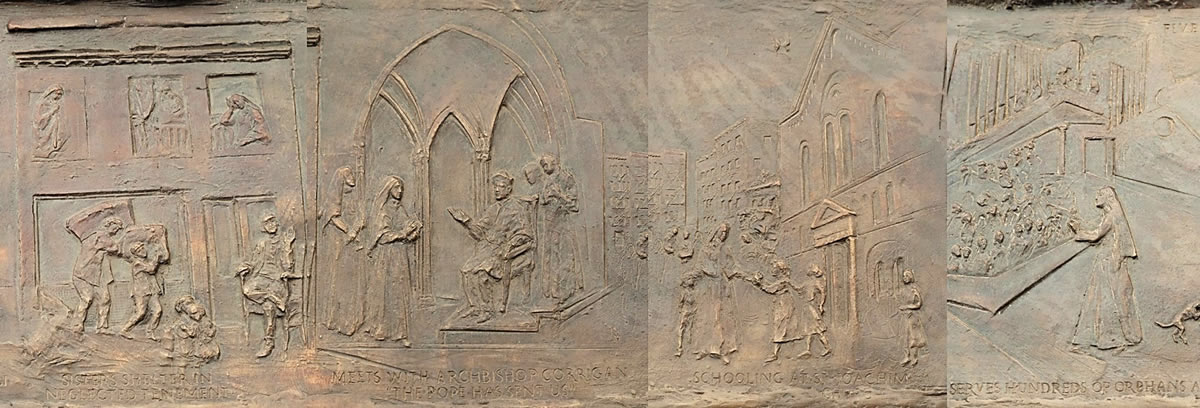
With discomfort and fear Mother Cabrini and the sisters manage to settle for the night in chairs in a neglected tenement building.
Shortly after her arrival, Mother Cabrini meets with Archbishop Corrigan, who makes it clear to her that it would be better if she left New York and returned to Italy. With resolution and diplomacy, she politely replies that she cannot go back because the Pope had sent them to America to help the many immigrants in need. Mother Cabrini is determined to carry out her mission.
On her first Sunday after Mass at Saint Joachim’s Church at the corner of Prince and Mott Streets, Mother Cabrini and the sisters are surrounded by mothers and fathers who introduce their children and speak of the circumstances in which they are forced to live and their harsh treatment in the United States. Shortly thereafter, Mother Cabrini starts a children’s choir at St. Joachim’s which swells to nearly 350 children. Under her supervision, immigrant children are offered medical care, education and comfort. Mother Cabrini receives, in return, contributions from the impoverished immigrants and a welcoming support from all, especially from the Sisters of Charity of New York.
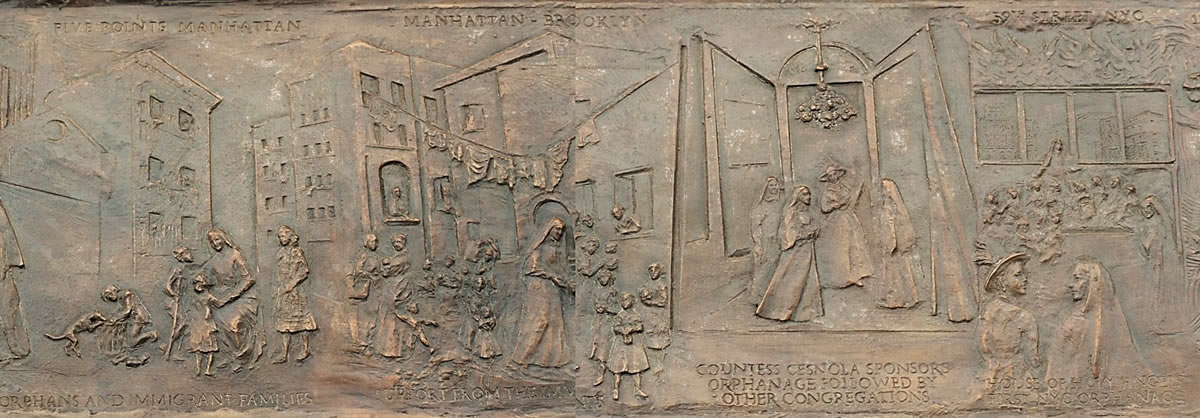
In the Five Points neighborhood of Lower Manhattan, Mother Cabrini witnesses the devastating living conditions of the immigrants. She makes it her mission to elevate the human condition and defend the rights of immigrants and needy. Mother Cabrini soon meets with Countess Mary Reid Cesnola to establish an orphanage for young girls. Her husband Count Luigi Palma di Cesnola, the director of the Metropolitan Museum of Art, becomes her strategic advisor and helps her navigate this new modern society. The Cesnola’s will remain supporters and friends of Mother Cabrini.
On April 21, 1889, Mother Cabrini opens an orphanage with the help of Countess Cesnola at 43 East 59th St. and names it House of the Holy Angels. Almost as soon as it is open, she focuses on moving the orphanage to a place that is located closer to immigrant neighborhoods and also capable of accommodating a greater number of children to assist in the physical and spiritual care of all children in need – orphans as well as children abandoned by immigrant families – who arrived in America to find far less than the riches that they imagined.

Mother Cabrini returns to Italy for a short time and within a few months of her return to New York, she purchases a beautiful property in West Park, affectionately called “Manresa.” Leveraging her upbringing as a daughter of farmers, her creative abilities, and her love for the land she finds a spring of water on the arid property where a well can be drilled. The orphanage is moved from Manhattan to this stable and more favorable location and it also becomes a place for the training of her “daughters.” With her guidance, the immigrant children under her care are taught English and American customs without losing track of the values and traditions of their homeland.
There are many impoverished Italian immigrants in desperate need of medical attention and who are unfamiliar with the language and American customs. Due to Mother Cabrini’s administrative and organizational skills, on July 25, 1891 she is implored by Archbishop Corrigan to assume responsibility of a hospital for the Italian immigrants. Mother Cabrini agrees under one condition: that it remains under her direction. Mother Cabrini ends the collaboration with the hospital’s owners and establishes a new hospital, with the generous help of the Countess Cesnola and her daughters and the encouragement of Archbishop Corrigan. It is the first hospital of the Missionary Sisters, and is named Columbus Hospital – eventually renamed Cabrini Medical Center – open to all, including those who cannot pay. Doctors donate their services free of charge.
East Panel

Despite her fear of water and her frail constitution, Mother Cabrini’s “sea legs” carry her 23 times over the Atlantic allowing her to continue her charitable missions dedicated to immigrants throughout North America and the world. In her life of 67 years she establishes 67 hospitals, schools, and other charitable institutions.
About the Artists
Jill Biagi studied at the University of Washington and she received a fellowship to work and study art in Pietrasanta, Italy with stone carving artisans. Giancarlo Biagi studied at the Istituto d’Arte Stagio Stagi of Pietrasanta before moving to the United States to attend the Art Students League of New York. Together, Jill and Giancarlo have created sculptures for several public commissions with the goal of capturing the life story and preserving the legacy of revered individuals. Additional works by these artists are found in major museums around the world. Jill and Giancarlo maintain studios in New York and Pietrasanta.